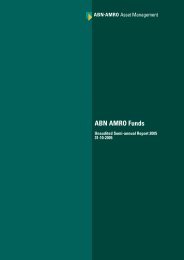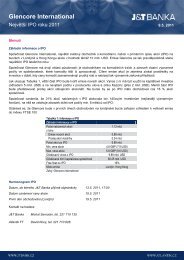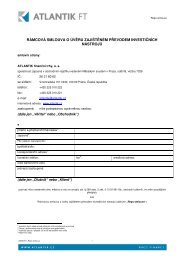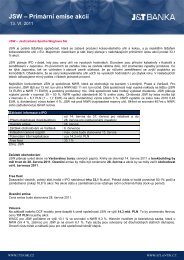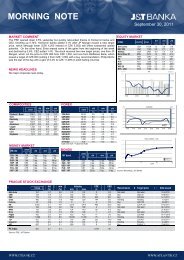ABN AMRO Funds - Aia.com.hk
ABN AMRO Funds - Aia.com.hk
ABN AMRO Funds - Aia.com.hk
Create successful ePaper yourself
Turn your PDF publications into a flip-book with our unique Google optimized e-Paper software.
NOTES TO THE FINANCIAL STATEMENTS<br />
1. Purpose of the SICAV<br />
<strong>ABN</strong> <strong>AMRO</strong> <strong>Funds</strong> (‘‘the SICAV’’) is an open-ended investment<br />
<strong>com</strong>pany incorporated on March 23, 1994 under the laws of the<br />
Grand Duchy of Luxembourg as a Société Anonyme, which qualifies<br />
as a Société d’Investissement à Capital Variable (SICAV). The<br />
SICAV is an ‘‘umbrella structure’’ under which its capital is divided<br />
into different investment portfolios of securities and other assets<br />
permitted by law with specific investment objectives and various<br />
risk characteristics (hereinafter referred to as the ‘‘<strong>Funds</strong>’’ and each<br />
a ‘‘Fund’’).<br />
There is no cross-liability between <strong>Funds</strong>. Each Fund is exclusively<br />
responsible for those liabilities attributable to it; the claim of any<br />
third party against a Fund can only be made against the assets of that<br />
Fund.<br />
The exclusive purpose of the SICAV is to manage its capital for the<br />
benefit of the Shareholders. For this purpose the SICAV invests the<br />
funds available to it in transferable securities, money market<br />
instruments and other assets permitted by law with the aim of<br />
spreading investment risks and affording its shareholders with the<br />
results of the management of its assets. The SICAV was originally<br />
authorised under part I of the Luxembourg law of March 30, 1988. In<br />
keeping with a decision of the general meeting of Shareholders on<br />
August 12, 2005, the SICAV is now authorised under part I of the<br />
Law of December 20, 2002 (‘‘the Law’’). The SICAV may take any<br />
measures and carry out any transaction which it may deem useful for<br />
the fulfillment and development of its purpose to the largest extent<br />
permitted under the Law on undertakings for collective investment.<br />
Each Fund can issue multiple Classes of Shares. Each Class<br />
represents an interest in the Fund’s portfolio, but may have its own<br />
characteristics, such as fee structure, investment minimum, dividend<br />
policy or reference currency. The types of Share Classes currently in<br />
existence are :<br />
Class A: Capital Growth Shares;<br />
Class B: Dividend Shares;<br />
Class D: Capital Growth Shares/Distribution Shares;<br />
Class I: Capital Growth Shares/Institutional Shares;<br />
Class J: Capital Growth Shares;<br />
AH, BH, DH, IH and JH Shares (‘‘Hedged Share Classes’’) may also<br />
be created. These Shares will have a substantial part of the assets of<br />
the SICAV attributable to that Share Class denominated in or hedged<br />
into the currency of that Share Class. The Hedged Share classes will<br />
be issued in a currency different from the reference currency of the<br />
Fund considered.<br />
During the year ended April 30, 2008, the following <strong>Funds</strong> were<br />
merged:<br />
Fund Merged into Ratio Date<br />
AAF High Yield<br />
Bond Fund (USD)<br />
AAF Preferred<br />
Securities Fund<br />
AAF 2001 Interest<br />
Growth Fund Euro<br />
AAF Biotech Fund<br />
AAF Global<br />
Emerging Markets<br />
Bond Fund (Euro)<br />
AAF High Yield<br />
Bond Fund (Euro)<br />
1 June 1, 2007<br />
AAF Absolute<br />
Return Bond Fund A B : : 1.006195333 June 1, 2007<br />
1.986618507<br />
D : 0.829957119<br />
A1 : 1.006232817<br />
B1 : 0.986579613<br />
D1 : 0.829926786<br />
AAF 2001 Euro 1.004720543 August 3, 2007<br />
Bond Fund<br />
AAF Health Care<br />
Fund<br />
AAF Global<br />
Emerging Markets<br />
Bond Fund (USD)<br />
A : 0.578380047<br />
A3 : 0.578493643<br />
D : 0.747535593<br />
August 3, 2007<br />
1 February 21, 2008<br />
During the year ended April 30, 2008, the following <strong>Funds</strong> were<br />
liquidated:<br />
Fund<br />
Date<br />
AAF Sustainable Global Credit Fund May 25, 2007<br />
AAF Denmark Bond Fund May 25, 2007<br />
AAF Global Leader Fund May 25, 2007<br />
AAF Europe Property Equity Fund April 21, 2008<br />
During the year ended April 30, 2008, the following <strong>Funds</strong><br />
contributed their assets to the SICAV:<br />
183<br />
Contributor<br />
<strong>ABN</strong> Transpacific<br />
Fund SICAV<br />
AAAI Global TAA<br />
Fund<br />
<strong>ABN</strong> <strong>AMRO</strong><br />
Rainbow Fund –<br />
EMU Government<br />
Bond - Passive<br />
Date<br />
ofcontribution<br />
September<br />
27, 2007<br />
October 19,<br />
2007<br />
December<br />
14, 2007<br />
Assetscontributed<br />
Name of receiving<br />
Fund<br />
EUR 24,271,044 AAF Japan<br />
Opportunities Fund<br />
EUR 118,663,158 AAF Global TAA Fund<br />
EUR 89,026,871 AAF EMU Government<br />
Bond – Passive Fund<br />
During the year ended April 30, 2008, the following <strong>Funds</strong> were<br />
launched:<br />
Fund<br />
Date<br />
AAF ARBF V150 September 21, 2007<br />
AAF Japan Opportunities Fund September 28, 2007<br />
AAF Europe Property Equity Fund October 12, 2007<br />
AAF Clean Tech Fund October 12, 2007<br />
AAF Global TAA Fund October 19, 2007<br />
AAF EMU Government Bond – Passive<br />
December 14, 2007<br />
Fund<br />
During the year ended April 30, 2008, the following Fund names<br />
were changed:<br />
Fund New Name Date<br />
AAF High Yield Bond Fund AAF High Yield Bond Fund June 1, 2007<br />
(Euro)<br />
AAF Absolute Return Bond AAF ARBF V300 September 21, 2007<br />
Fund<br />
AAF Global Emerging<br />
Markets Bond Fund (USD)<br />
AAF Global Emerging<br />
Markets Bond Fund<br />
February 21, 2008<br />
2. Summary of Significant Accounting policies<br />
The financial statements are prepared and presented in accordance<br />
with generally accepted accounting principles applicable to investment<br />
funds in Luxembourg.<br />
a. Principles of valuation<br />
For each Share Class of each Fund, the Net Asset Value (NAV) per<br />
Share is expressed in the applicable reference currency of the<br />
relevant Fund or Share Class as defined in the Prospectus. The NAV<br />
per Share is determined as of each Valuation Day. For any given<br />
Fund and Share Class, the NAV per Share is calculated by taking the<br />
portion of SICAV assets attributable to that Fund and Share Class (as<br />
valued according to the valuation policies below), subtracting the<br />
portion of SICAV liabilities attributable to that Fund and Share<br />
Class, and dividing the result by the total number of Shares<br />
outstanding in that Fund and Share Class then outstanding. NAV per<br />
Share may be rounded up or down to the nearest unit of the relevant<br />
reference currency, as determined by the Board of Directors.<br />
In certain prevailing market conditions, taking into account the level<br />
of buying and selling in a relevant Fund and the size of the Fund, the<br />
Board of Directors may consider it in the best interest of<br />
Shareholders to calculate the NAV per share of such Fund using<br />
securities bid or offer prices and/or by applying an estimate of the<br />
bid or offer spread applicable to the markets in which the Fund’s<br />
securities are traded. It may further adjust such NAV for any dealing<br />
charges and sales <strong>com</strong>missions incurred, provided always that such<br />
dealing charges and sales <strong>com</strong>missions shall not exceed 1% of the<br />
net asset value of the Fund at such time.<br />
The value of the assets shall be determined as follows:<br />
1) The value of any cash on hand or on deposit is recorded at<br />
book value;<br />
2) The value of transferable securities and money market instruments<br />
and any other assets listed or dealt in on any regulated<br />
market and/or any other regulated market is based on the last<br />
available price on the relevant markets, on which such investments<br />
are traded, of each Valuation Date. Depending on the<br />
market in question, the relevant closing price used, will either<br />
be the business day in that market preceding the relevant Valuation<br />
Date or on the same business day as the Valuation<br />
Date;



